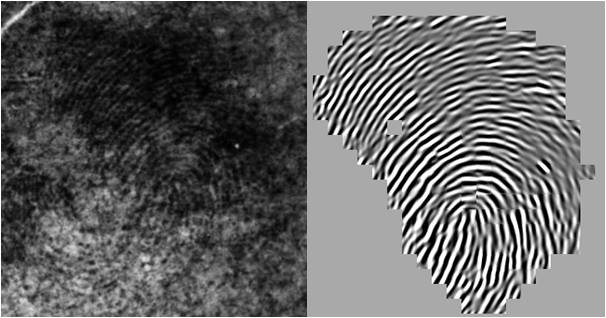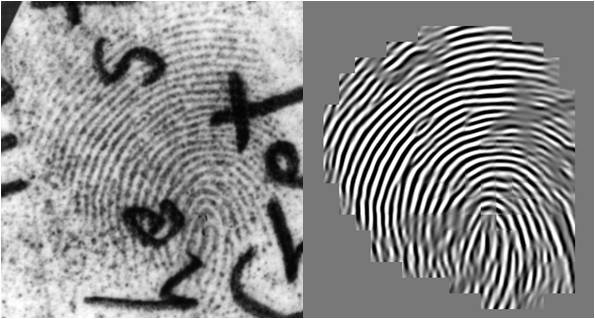 |
Current Projects
Latent Fingerprint Enhancement
Automatic feature extraction in latent fingerprints is a challenging problem due to poor quality of most latents, such as unclear ridge structures, overlapped lines and letters, and even overlapped fingerprints (see Fig. 1). In the current practice, latent examiners are required to mark minutiae and optionally extended features such as dots, incipient ridges, pore, etc. The goal of this research is to improve the automatic feature extraction accuracy in the enhanced latent fingerprints as well as to provide the enhanced images to the latent examiners for manual markups.
In this research project, we are developing a semi-automatic latent fingerprint enhancement algorithm which only requires manually marked region of interest (ROI) and singular points (e.g. core and delta). Marking these features is generally less time-consuming and requires less expertise than marking minutiae. The proposed algorithm consists of two phases: (i) fingerprint orientation field estimation, which fits an orientation field model to the coarse orientation field estimated from skeleton provided by a commercial fingerprint SDK, and (ii) fingerprint ridge enhancement by Gabor filtering. Experimental results on NIST SD27 (a public domain latent fingerprint database) indicate that, by incorporating the proposed enhancement algorithm, the matching accuracy of the commercial matcher was significantly improved. Fig. 2 shows the examples where the proposed enhancement algorithm improves the retrieval rank of the mated fingerprint in the large background database with 15,758 images.
 |
| Fig. 1: Latent Fingerprints: partial area, unclear ridges, overlapped with other fingerprints, and complex background, respectively. |
 |
 |
| (a) |
(b) |
| Fig. 2: Examples of successful latent fingerprint enhancement. (a) Latent with poor ridge structure: retrieval rank in the background database with 15,758 fingerprints improved from 2258 to 11, and (b) latent with background noise: retrieval rank improved from 113 to 9. |
J. Feng, J. Zhou, and A. K. Jain, "Orientation Field Estimation for Latent Fingerprint Enhancement", IEEE Transactions on Pattern Analysis and Machine Intelligence, 2012 (To Appear).
S. Yoon, J. Feng, and A. K. Jain, "Latent Fingerprint Enhancement via Robust Orientation Field Estimation", IJCB, Washington, DC, Oct. 11-13, 2011.
S. Yoon, J. Feng, and A. K. Jain, "On Latent Fingerprint Enhancement", Proc. of SPIE, Biometric Technology for Human Identification VII, April 2010.
|
 |



